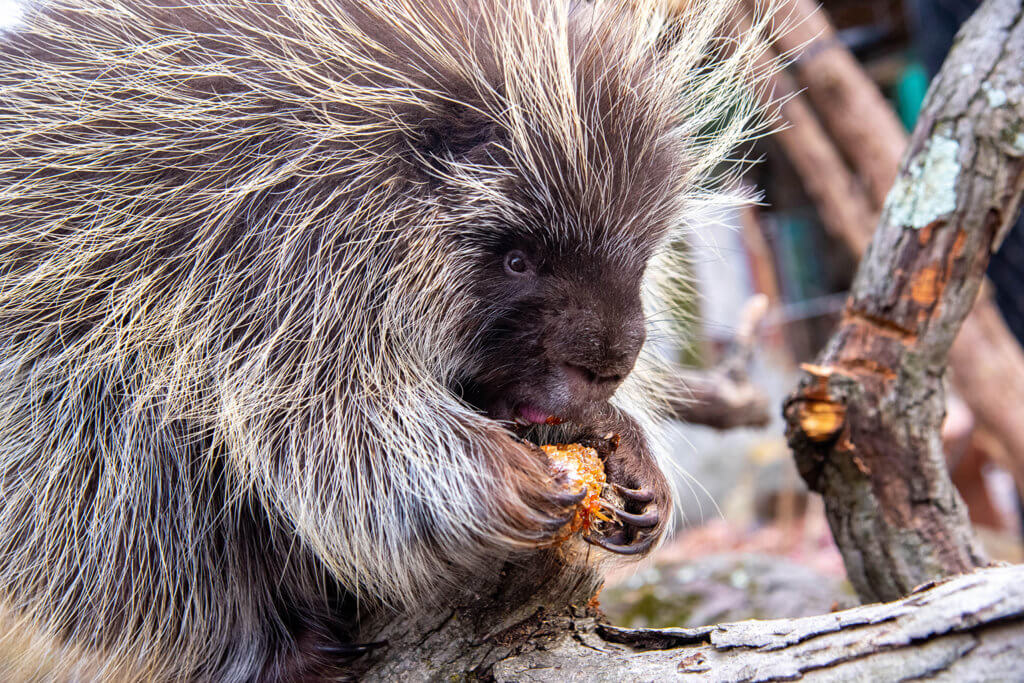Overview
“Where I live”
North American porcupines have a wide range throughout the continent, from the southern half of Canada, throughout much of the United States and into Mexico. Within the U.S. North American porcupines can be found mainly in the northern and western parts of the country, with scattered populations in eastern states. With a range this broad, North American porcupines are adapted to survive in diverse habitats, from dense forests, to tundra, to desert scrubland.
“How I live there”
North American porcupines belong to a group called New World porcupines. “New World” generally refers to species native to North, Central, and South America. Compared to other New World porcupines, North American porcupines can tolerate a much wider range of temperatures. Although they do not hibernate in winter, they will stay inside their den–a decaying log or hollow tree–as protection from extreme cold and snow.
North American porcupines are not very social and spend most of their time alone. A female North American porcupine defends her territory against other females. Her territory is generally smaller than a male’s, however. A male will guard his territory fiercely against another male, and the most dominant males typically have the largest territories.
With long claws, pebble-textured soles, and excellent sense of touch, the feet of a North American porcupine allow the animal to navigate trees securely. A porcupine can use its back feet to anchor itself into a tree with its quills acting as an additional backstop to keep from sliding. Stabilized well, the porcupine can then use its front feet to feed on items like stems, leaves, and bark.
“Making my mark”
The quills of a porcupine are perhaps its most identifiable trait. An individual may have 30,000 quills on its body. Each quill is a modified hair and it has a tiny barb on its tip. The barb allows the quill to lodge easily in the skin and muscle of a predator. But while the quills can release easily on contact, the porcupine cannot actually shoot its quills.
Along with their tree-climbing ability, North American porcupines are generally good swimmers. They can be quite vocal, and make a variety of calls including grunts, whines, squeaks, and chatters.
Porcupines have a strong taste for salt, and their eagerness to attain this important nutrient can bring them into conflict with humans. They will chew on homes, cars, plywood, or anything with salt residue. This behavior is particularly common in areas where salt is used to de-ice roads.
“What eats me”
When threatened, a North American porcupine will first choose to escape by climbing a tree. If retreat is not an option, the porcupine will give ample warning to a would-be predator, chattering its teeth, releasing an unpleasant odor, and raising its quills. If the predator ignores these warnings, and comes close enough that it touches the quills, the quills can snag into the predator’s skin.
In spite of its multifaceted defense system, North American porcupines can become prey for species that evolved to navigate those prickly defenses. Animals such as bobcats, coyotes, wolves, wolverines, mountain lions, lynx, fishers, and great horned owls have all been known to prey on North American porcupines.
Raising Young
Female North American porcupines announce their readiness to mate by scent marking with urine and vocalizing at a high pitch. The males that she attracts then fight for dominance using their quills and teeth. The victor may then get to mate with the female—if she is willing.
North American porcupines breed once per year in the fall. After a pregnancy of about seven months, a female gives birth to a single offspring. For the first six weeks of life, the baby porcupine–or porcupette–is hidden on the ground during the day while the mother sleeps close by in a tree. At night they reunite on the ground. Over the next few months, the porcupette travels at night from tree to tree, waiting while she climbs each tree in search of food. Gradually, the porcupette forages and rests at greater distances from mothers. After around five months, the young porcupine separates from its mother completely.
Taxonomy
- Kingdom: Animalia
- Phylum: Chordata
- Subphylum: Vertebrata
- Class: Mammalia
- Order: Rodentia
- Family: Erethizontidae
- Genera: Erethizon
- Species: dorsatum

